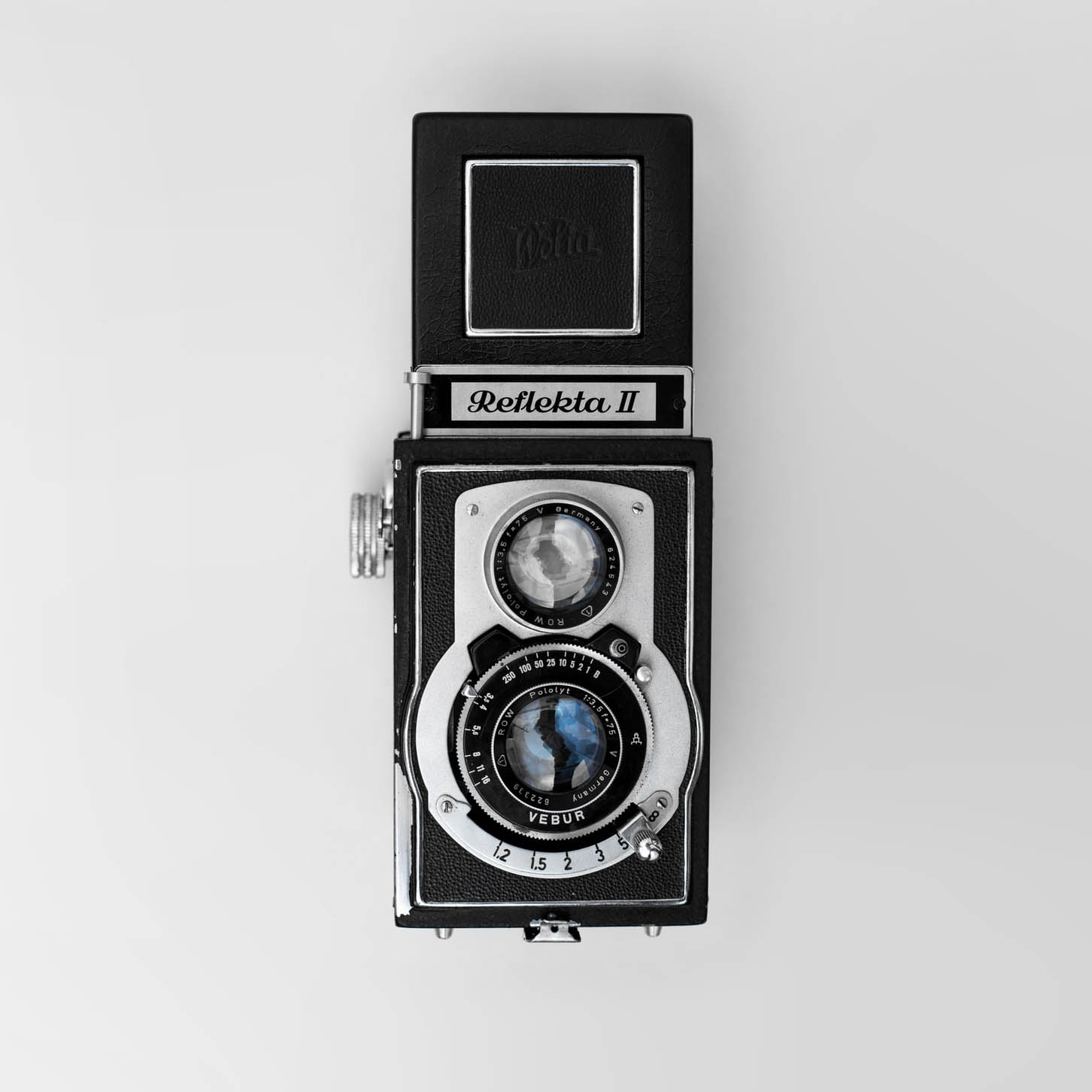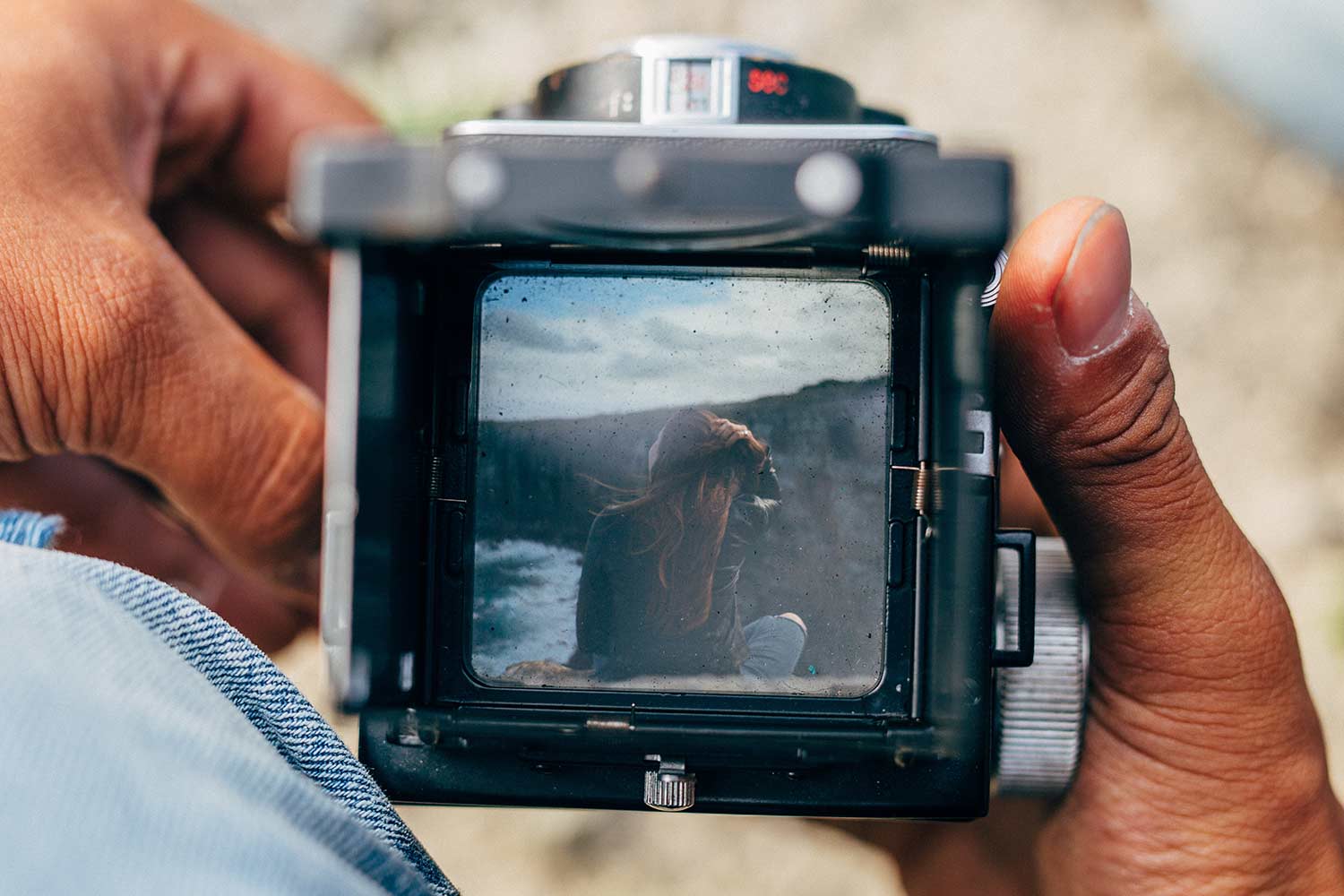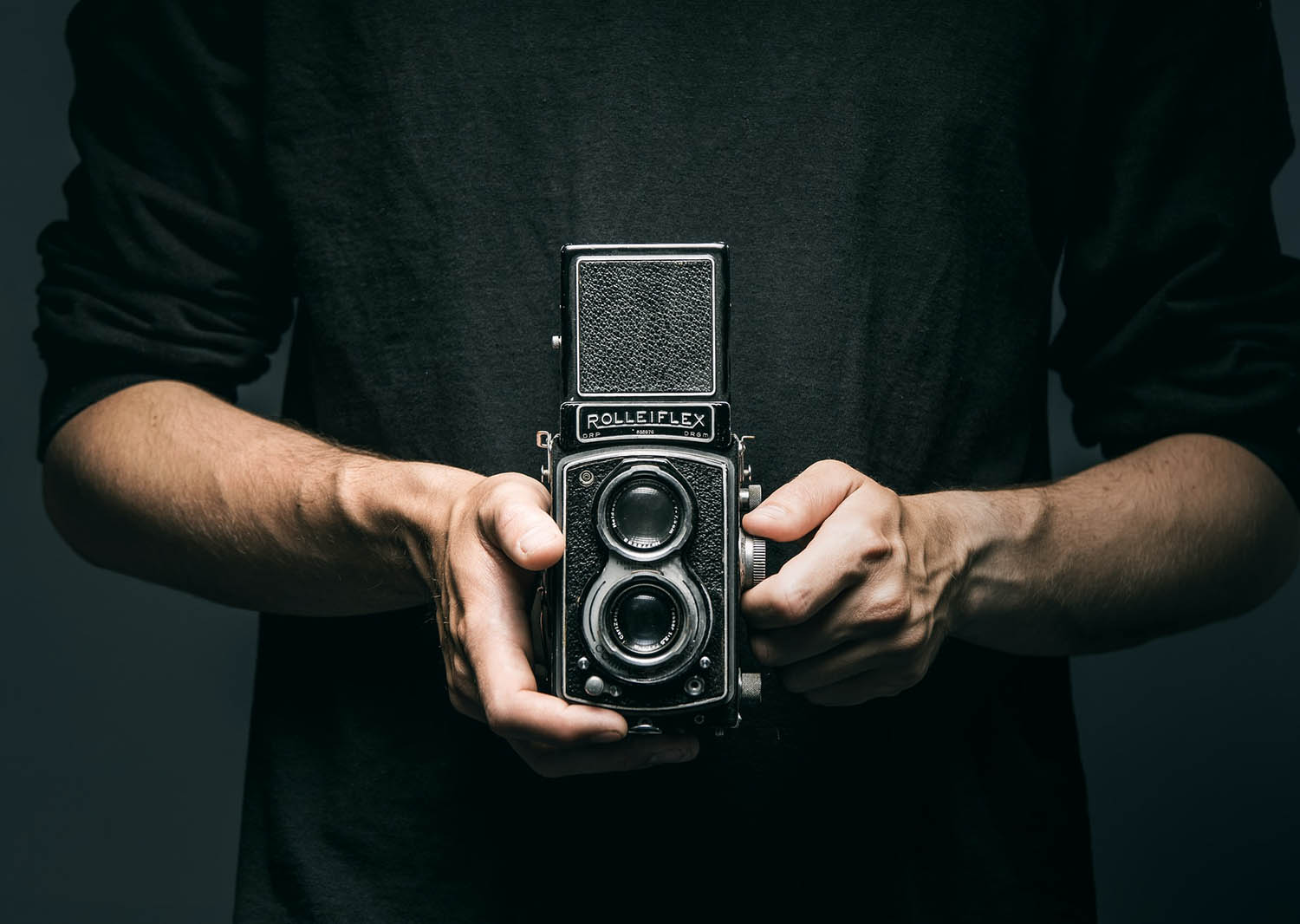What is TLR in photography? – A twin lens reflex camera.
They use two lenses, one for composing the picture, and one for taking the picture, and they look like this:

35 millimetre format cameras dominate camera sales, but there are other camera systems that have larger sensors or use larger film.
A TLR camera is referred to as a medium format camera as it uses a film called 120 roll film. Simply, it’s on a roll and it’s bigger than 35mm.
The 120 roll film is used by amateurs and professionals alike because of the superior image quality and greater potential for cropping due to the negative being so much bigger than a 35mm piece of film.
There are a number of medium cameras, including twin lens reflex (TLR) cameras that handle 120 roll film.
TLR cameras aren’t manufactured as new but are still available on the second hand camera market, the principal brands of camera you are likely to find are Rollei, Mamiya and Yashica.
The main advantages of TLR cameras are compactness, reliability and the simplicity of the leaf shutter system.
If you saw in the news not long ago about the discovery of Vivian Maier’s body of work, you can see her reflection in some of her photographs that show her using a TLR.
How TLRs work
The standard TLR camera uses a separate optical system for viewing and taking a photograph.
The two lenses are close together on a panel so that although the viewfinder is separate, it sees a field of view nearly identical to that of the taking lens.
By separating the viewfinder and main camera sections in this way, the considerable cost of the mirror that SLRs use and focal plane shutter mechanisms is cut out, and less complex designs of lens can be used.
Because the whole front panel of the camera moves outwards as you focus, both lenses are always in perfect synchronisation.
The image is normally viewed on a waist level screen and seen upright but reversed side to side, as in a mirror. A pentaprism is available for some models, and this allows correct viewing of the image.
A waist level viewfinder is super cool, and looks like this:

The ground glass screen may have a focusing spot in the centre just like a 35 millimetre SLR and may have a split image rangefinder.
There may also be parallel road lines to help composition, and perhaps a moving pointer to indicate parallax error, as you focus closely and magnify it enables up to the eye viewing and fine focusing and the light shield often has a neat push through arrangement to make a direct viewfinder to follow action at eye level.
DSLR cameras usually have fixed lenses, although I think there is one TLR made with interchangeable lenses, TLR cameras generally have fixed lenses and as such, can be light and quiet because they use a leaf type shutter.
There are few parts to go wrong and even today they make the medium format available at a reasonable price. A Rollei TLR will still set you back £600, but there are cheaper vintage models still around and Lomo makes a plastic one for dead cheap.
What is the difference between SLR and TLR?

- The SLR has one lens, and the TLR has two.
- A 35mm SLR uses 35mm film, a TLR uses medium format film called 120 roll film.
- SLRs typically have interchangeable lenses, TLR lenses are typically fixed.
- SLRs typically have a viewfinder that you put up to your eye, TLRs have viewfinders at waist level.
To learn more about the SLR, you can read an introduction to the SLR and DSLR.
The lens on a TLR is normally a 75mm or an 80mm f/2.8 or f/3.5, often with excellent performance.
This is similar to using a 50mm lens on a 35mm film camera, although a given aperture depth of field is greater with the 50mm lens, parts of the image on the film can be enlarged without much loss of quality.
An enlargement from a 24x36mm area of a 56x56mm negative is as good as an enlargement from a full 35mm negative, or the full frame can be used for ultimate sharpness and freedom from grain.
SEM in France made a studio Semflex with a 150 millimetre portrait lens. Yashica made a TLR camera that had telephoto and wide angle attachments, which fit in the front of TLR lenses to produce slightly wide and telephoto effects with some loss of quality. I’ve no idea how rare these are, if you find one in a second hand shop for cheap just buy it and find out later.
Interchangeable lens TLR cameras were introduced for extra versatility.
Mamiya produced the Mamiya C series of twin lens models with interchangeable lenses by making the front panel of the TLR removable and fitting a special capping shutter (which covers the film when the lever unlocking the lens panel is operated).
To cope with the various focal lengths bellows are fitted to these cameras for focusing, and as a result they extend enough to focus very closely with standard and wide angle lenses (with a wide angle lens, focusing down to 15 centimetres is made possible).
In the process the TLR becomes far heavier and larger, but retains all its other advantages of quietness and operational ease.
Combined with sophisticated methods for correcting parallax for close ups and improved interchangeable viewing screens and eye level prisms if needed, the Mamiya TLR is nearly as versatile as an SLR. The lens pairs are each fitted with a matched set of lenses and its own leaf shutter.
With the Mamiya system you can have two bodies in operation with different films and change lenses between them.
The great joy of TLRs is using the waist level viewfinder. As the name suggests, you hold the camera at waist level and look down upon the top of it. The glass screen shows you a miniature version of the scene you are looking at and allows for close examination of the scene as a whole.
Depth of field can be seen through the glass screen and it makes composition much easier.
As the format is square, there’s also no need to rotate the camera for portraits or landscapes as the dimensions are the same across either edge. The negative can be cropped during printing to achieve the desired dimensions.
How do you use a TLR camera?
With wind-on usually accomplished by a single turn of a lever on the right hand side of the camera, and the focusing of a knob on the left, the TLR is very quick to use.

You focus first and then drop the camera to waist level or about 30 centimetres below the eye, enabling the total composition to be assessed impartially like a miniature picture on the screen.
If the subject does not move, you do not raise the TLR to the eye level again, because it has a square picture shape 56×56 millimetres, you never need to turn the camera on its side, simply make a mental allowance for horizontal vertical square composition as required.
The camera can be held over your head, upside down, to get shots over the tops of walls or crowds and some can be fitted with an eye level pentaprism to make it like an SLR camera.
Roll film is best used for subjects where fine detail, tonal quality and composition are the important factors, not speed of the photographer’s reactions.
The classic roll film subject subjects are weddings, portraits, architecture, landscapes and still life.
The medium requires patience as accurate exposure readings are needed to get the best out of it. There’s no point in spending £1000 on a second hand camera to then go out taking pictures without a light meter.
I love medium format film, there’s something so exciting about the size of it. Processing costs are an issue if you wish to use a lab, so you may have to develop the film yourself if you’re looking for a long term project.
However if you have the time and patience, TLRs make wonderful travel cameras as they are so light and easy to use. They do require patience and precision, but it’s so easy to visit a new place and become overwhelmed by new sights and sounds. Using a TLR can be incredibly rewarding as it forces you to slow down and take your time crafting an image, rather than snapping and hoping for the best.
120 roll film
The description of 35 millimetre film is easy to grasp because the film itself is actually 35 millimetres wide (although the sprocket holes take up one third of its width).
But why 120 roll film?
When George Eastman sold the first roll film cameras in the 1890s, the foundations were laid for a system of describing roll film by numbers.
Size 20 was 62 millimetres in width.
The addition of a prefix 1, 6 or 8, indicated a variation on the way that the film was spooled and the shape of the format allowed for in the frame numbers on the backing paper, which were viewed through a red window on the camera back.
There were other sizes, but gradually the multiplicity of roll film sizes dwindled and the last survivors were 120, 127, 620, and 828.
As far as I’m aware, today only 120 remains.
220 was a thing at one point in history, which is identical in spooling to 120, and uses a short paper leader splice to a longer roll of film to double the number of exposures to 20.
Also referred to as medium format film, 120 roll film is only suitable for certain cameras.
Cameras with formats of 6x9cm, 6x7cm and 6x6cm all use 120 roll film. A six by six negative or slide is not as large as it seems. They normally measure only 56x56mm. Some 3.63 times greater in area than a 35mm standard frame. Each 120 roll film can accommodate 12 of these exposures, or up to 16 measuring 56x45mm.
